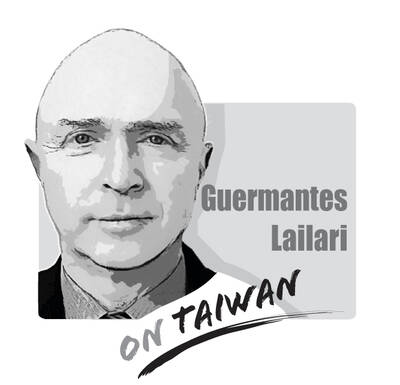Statues of former president Chiang Kai-shek (蔣介石) dotting school campuses and public spaces nationwide are the subject of fierce debate at this time of year — the anniversary of the 228 Incident — and increasingly so in the past five years.
On Wednesday, National Sun Yat-sen University announced it was establishing a committee to determine the fate of a Chiang statue on its campus. The university is using the opportunity to get students, faculty and alumni talking about the issue.
On Tuesday, the Tainan City Government removed a statue of Chiang from a roundabout, the third such removal in the city this month.
Last month, National Chengchi University passed a motion calling for its statues of Chiang to be removed as part of efforts to promote human rights and transitional justice.
These are not isolated incidents. Two years ago, the Tainan City Government removed statues from 14 elementary and junior-high schools as part of a concerted effort to rid the city of symbols of dictatorship.
The Cihu Memorial Sculpture Garden, adjacent to Chiang’s mausoleum in Taoyuan’s Dasi District (大溪), where many of the statues and busts of the former president removed from schools, parks and other places have been discarded since 2000, is getting pretty crowded. There are already more than 200 orphaned statues there.
There is plenty of debate surrounding whether these statues should be removed. Does it constitute historical vandalism, a whitewashing of Taiwan’s past? What purpose do these statues serve? They are memorials to a late dictator.
All memorials are political spectacles. It is one thing to have these statues at Chiang’s mausoleum or premises specifically to commemorate him. However, placed in schools, the statues legitimize Chiang and condone his actions. In parks and other public spaces, it enforces a sense of shared narrative.
Over the past few years, more young people have rallied against this narrative, in many cases when marking the 228 Incident anniversary.
Last year the dictator’s statues were defaced in numerous locations, including Yilan, where someone wrote “Taiwan’s Hitler.”
When a nation’s schools and public spaces are dominated by images of mostly one person, specifically a national leader, it starts to look suspiciously like the trappings of a personality cult, a symbol intentionally employed to legitimize a regime. When that leader came from outside and headed a foreign regime, it looks like a symbol of colonialism.
When the Chinese Nationalist Party (KMT) first came to Taiwan, having statues and busts of its leader erected at schools and in public spaces served a definitive purpose. This same need led Chiang to order the 228 Massacre. That is why it is unconscionable that the KMT opposes efforts to have those same statues removed.
The government is attempting to bring about transitional justice. It is seeking the truth, holding those responsible for wrongdoing to account and introducing a more desirable social reality, allowing people to move on.
This is an opportunity. Local governments can remove the statues of a dictator, symbolic of a cruel and unjust past under a foreign regime, and replace them with meaningful celebrations of individuals or events that have made real, positive contributions to Taiwan. Better still, recast these symbols from the melted-down bronze or steel of the dictator’s statues. What more fitting symbol of transitional justice could there be?

“History does not repeat itself, but it rhymes” (attributed to Mark Twain). The USSR was the international bully during the Cold War as it sought to make the world safe for Soviet-style Communism. China is now the global bully as it applies economic power and invests in Mao’s (毛澤東) magic weapons (the People’s Liberation Army [PLA], the United Front Work Department, and the Chinese Communist Party [CCP]) to achieve world domination. Freedom-loving countries must respond to the People’s Republic of China (PRC), especially in the Indo-Pacific (IP), as resolutely as they did against the USSR. In 1954, the US and its allies
A response to my article (“Invite ‘will-bes,’ not has-beens,” Aug. 12, page 8) mischaracterizes my arguments, as well as a speech by former British prime minister Boris Johnson at the Ketagalan Forum in Taipei early last month. Tseng Yueh-ying (曾月英) in the response (“A misreading of Johnson’s speech,” Aug. 24, page 8) does not dispute that Johnson referred repeatedly to Taiwan as “a segment of the Chinese population,” but asserts that the phrase challenged Beijing by questioning whether parts of “the Chinese population” could be “differently Chinese.” This is essentially a confirmation of Beijing’s “one country, two systems” formulation, which says that
Indian Prime Minister Narendra Modi arrived in China yesterday, where he is to attend a summit of the Shanghai Cooperation Organization (SCO) with Chinese President Xi Jinping (習近平) and Russian President Vladimir Putin today. As this coincides with the 50 percent US tariff levied on Indian products, some Western news media have suggested that Modi is moving away from the US, and into the arms of China and Russia. Taiwan-Asia Exchange Foundation fellow Sana Hashmi in a Taipei Times article published yesterday titled “Myths around Modi’s China visit” said that those analyses have misrepresented India’s strategic calculations, and attempted to view
When Chinese President Xi Jinping (習近平) stood in front of the Potala Palace in Lhasa on Thursday last week, flanked by Chinese flags, synchronized schoolchildren and armed Chinese People’s Liberation Army (PLA) troops, he was not just celebrating the 60th anniversary of the establishment of the “Tibet Autonomous Region,” he was making a calculated declaration: Tibet is China. It always has been. Case closed. Except it has not. The case remains wide open — not just in the hearts of Tibetans, but in history records. For decades, Beijing has insisted that Tibet has “always been part of China.” It is a phrase